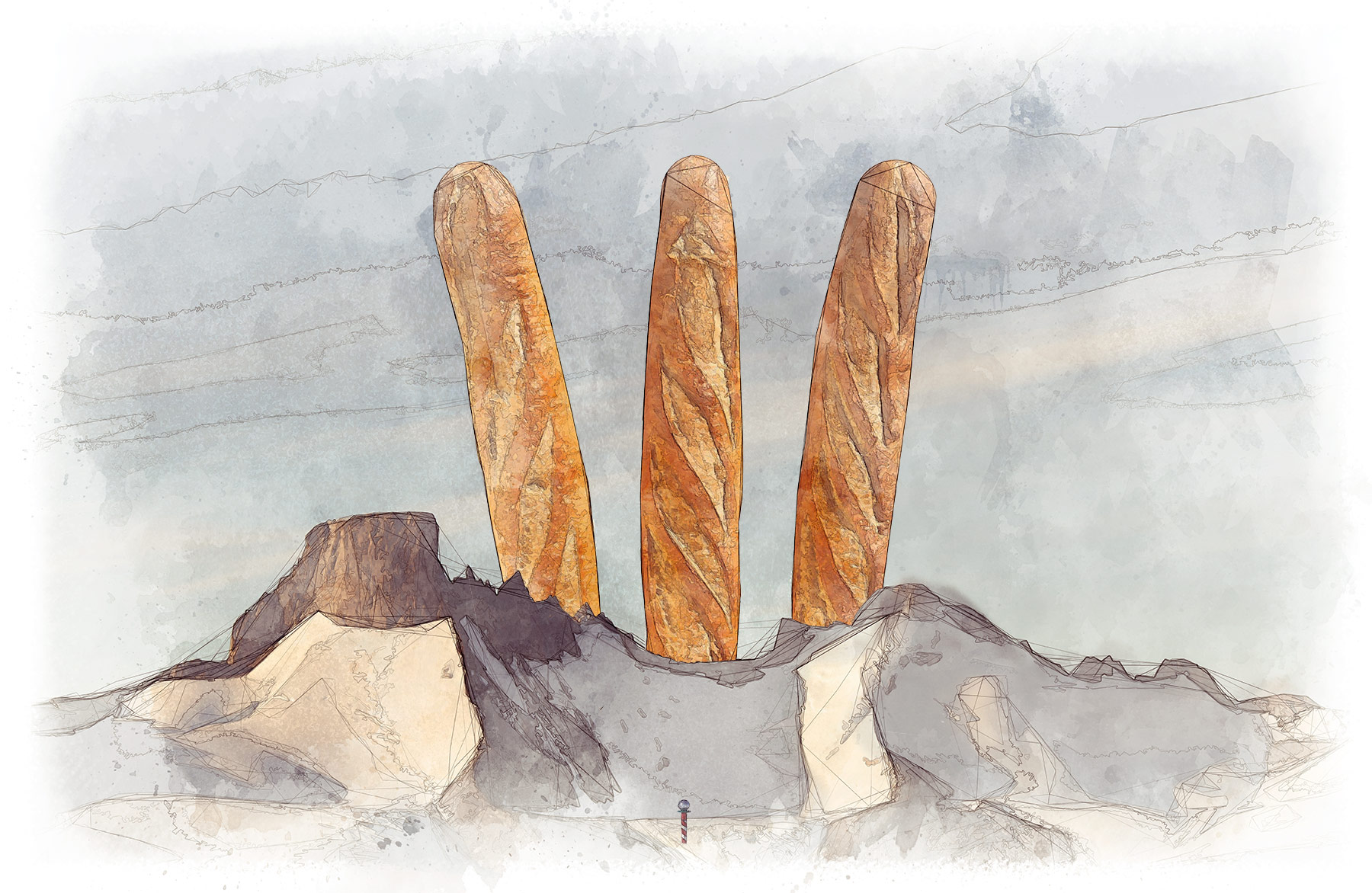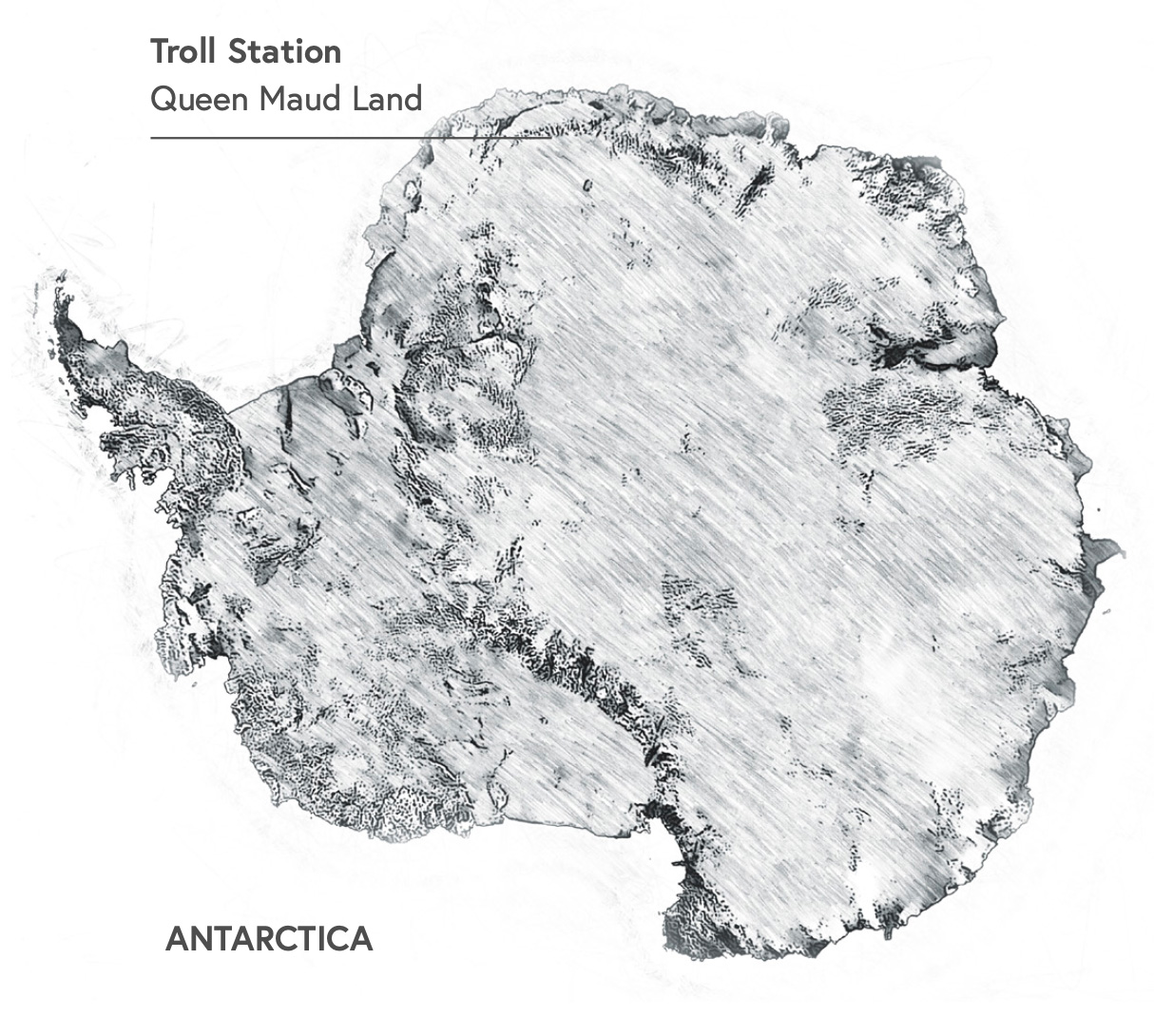
Antarctica — Jan. 12, 2021
Baking Bread at the Bottom of the World
Isolated in Antarctica, chef Karin Jansdotter finds comfort in new culinary hobbies.
This story can also be found in our Winter 2021 issue of Life & Thyme Post, our limited edition newspaper for Life & Thyme members. Subscribe
When the COVID-19 pandemic hit, the world stopped. People retreated indoors. And they baked.
Baking bread—sourdough, in particular—became one of the defining trends of the early lockdowns. Flour joined the ranks of toilet paper, hand sanitizer, and dried beans as supermarket rarities. People—anxious and scared over the sudden upheaval of normal routines—found security, comfort and control in the calming, repetitive motions of kneading dough and the warm, primal smell of bread baking in the oven.
Even the farthest reaches of the globe weren’t exempt from this sourdough craze.
At the isolated Troll Station—a smattering of red buildings surrounded by ice sheet occasionally pierced by mountain ridges and spires—in Queen Maud Land, Antarctica, head chef Karin Jansdotter took up sourdough baking to make fresh bread for Troll’s six-person crew during their winter-over period. Experimenting with rye whole wheat and wheat, she’s even named her two starters after characters from Johan Falk, a Swedish crime show the team has been watching during their time on the ice.
“It’s been my little joy during the dark season,” she says, explaining how the lack of distractions and necessity of cultivating creative hobbies allowed her the time to delve into the world of sourdough.
Having been stationed at Troll—a year-round research station with the Norwegian Polar Institute that studies a wide range of subjects from geology to meteorology—since November of 2019, the COVID-19 pandemic has largely passed Jansdotter and her team by. After supplies for the winter months were last delivered in late February of 2020, the station had no contact with the outside world until the first summer resupply flight at the end of November. Extreme caution is taken to ensure the virus doesn’t reach the continent, so during the long winter months, stuck indoors by bad weather and freezing temperatures and even more isolated than the rest of the world, Jansdotter also turned to baking and cooking as a means of meditation and self-expression.
“We have nowhere to go, and we have our chores that everyone does every day—there’s no stress. So, having no stress, it frees your mind to be creative,” Jansdotter explains. “I’m creative with the food.”
Baking bread on a continent with sub-zero temperatures isn’t without its challenges. While the station is heated, many rooms still have a chill or draft, so Jansdotter has to store her starters in a hallway with a radiator. The sterility of both the base and the overall continent also means that perhaps the starter is not as nutritious as it could be, lacking natural airborne bacteria.
In addition to her sourdough, Jansdotter has also been experimenting with fermentation by whipping up large batches of kimchi, pickling red onions, and making sauerkraut from white cabbage.

___
In a non-arable environment like Antarctica, food is about much more than sustenance. After long days of repetitive tasks and fixed schedules, it’s a break from routine, with a varied menu offering something new to look forward to. It’s a splash of color against a world of black and white, and an opportunity for experimentation and creativity. Food is a link between a remote outpost and the broader world, a connection to culture and identity.
But perhaps most of all, food is about life. On a continent where hardly anything grows, to watch something like a bread starter or a fermented product you made with your own hands come to life is a radical, deeply human act.
“Nothing grows here, so seeing something bubble and change, it’s the highlight of a day to check in on my fermentations and see how it’s going,” Jansdotter says. “It’s something to look at and smell.”
Especially during the long austral winter, which lasts from roughly late February to October, there is no access to new ingredients and many foodstuffs are frozen. With such limited supplies, crafting both filling and fulfilling meals becomes about approaching and appreciating food from its most basic elements like scent or texture, as well as using salt, good butter, and olive oil to enhance a meal. The tangy smell of sauerkraut or the crunch of Chinese cabbage in kimchi is further elevated against a continent with few natural smells and no fresh vegetables.
“You have what you have,” says Jansdotter, “and you learn to make the best of it.”
___
In Antarctic cuisine, scarcity and necessity are directly tied to creativity and innovation. For modern-day chefs like Jansdotter, that can manifest as experimenting with fermentation, both to extend the viability of perishable foodstuffs and to shake things up at meal time by offering diverse types of food on top of familiar staples like pasta, stews and curries.
“A chef’s urge and ability to be creative in Antarctica comes from both the supply side and the demand side,” says Jason C. Anthony, who, based on his years of experience at McMurdo Station, wrote a book entitled Hoosh: Roast Penguin, Scurvy Day, and Other Stories of Antarctic Cuisine about the history and evolution of Antarctic food culture from the early days of explorers to the modern era. “The supply side is especially obvious … where you have to work with the constraints of your larder. And then there’s demand, i.e. the very special relationship between a cook and their captive audience. A good cook makes so much difference in the lives of isolated people.”
This link between limited supplies and needing to think outside the box dates to the early days of Antarctic exploration. Nowadays, when bases are restocked with food and supplies, there are more than enough redundancies to ensure the base doesn’t go hungry, even in case of emergency or delayed shipments. But back when explorers were dispatched to the bottom of the world with no chance of aid, they had to make do.
“From the start, we showed up with as much food as we could carry and then supplemented it with local meat from seals and penguins,” says Anthony. “That fresh meat was essential for the survival of expeditions in the first half of the twentieth century. They were coming down for a year or two and couldn’t afford or count on a resupply ship, and so couldn’t carry enough food. Plus that fresh meat, if prepared properly, helped keep away scurvy. To be clear, hunting locally didn’t make early Antarctic eating unique, but the context did.”
As a continent whose human inhabitants are not and never have been native, the implementation of hunting local species (which is no longer permitted) or using fermentation to preserve perishables culturally links the new societies of the far south to established Indigenous societies and cultures of the far north, like the Inuit, for whom fermenting meats has been a long-held tradition. This presents an intriguing experiment in what happens when human traditions, values and survival methods are introduced onto a blank slate: What sticks? What changes? How do you live off the land, but also in harmony with it? How do you adapt?
“There is no Antarctic cuisine per se, just national programs each feeding their personnel an approximate version of their national cuisine,” Anthony says. “In that sense, you can imagine it (as many have) as a forerunner of national bases on the moon or Mars.”
The evolving world of Antarctic food culture also offers interesting insights into the future of human food culture and agriculture. The melting of Antarctica’s ice sheets due to climate change will raise sea levels, drowning low-lying farming land, and contribute to the shifting climate that will change how and where—and how much—food can be grown and produced. These outcomes will have an impact on global food supply, which will in turn affect Antarctica’s research bases.
“Bases in Antarctica are just outposts of the home country, and they are very reliant on that logistical tether to home. When climate change disrupts agricultural and economic systems, the outposts will be impacted,” Anthony says. It is true that Antarctica’s research bases completely depend on the outside world to continue operating. If there isn’t enough food to go around or there’s a budget crunch, maintaining an expensive remote base likely wouldn’t be a top priority. In this case, the extreme stockpiling that early explorers had to do to make up for lack of resupply missions could once again become standard practice.
But even that may change, as technology improves. Antarctica acts as a perfect laboratory for scientists to develop agricultural systems for lunar or planetary bases through experiments like the EDEN ISS, a sustainable greenhouse that’s been able to grow tomatoes, cucumbers and lettuce.
With the development of forward-thinking projects like EDEN ISS and making use of food preservation methods like fermentation that Indigenous tribes have used for centuries to thrive in harsh polar environments, the only continent that does not naturally host humans stands to be one of the few to trailblaze the way forward for humanity.

___
For now, operations continue running smoothly on the continent, in spite of COVID-19. Having extended her stay at Troll until the end of the summer season in early 2021, Jansdotter will be heading home before winter starts, where she looks forward to cooking outside and enjoying the pleasures of sourcing fresh food from the landscape instead of frozen containers.
“It’s like a big adventure to be here,” she says, looking back on over a year spent on the ice. “It is just the most amazing adventure and experience.”
Along with the many lessons she’s taken away from her time in Antarctica—learning to slow down, being kind to herself and her body under extreme conditions, and echoing a sentiment of many Antarctic alums that material goods don’t matter as much—there’s another special souvenir she and each member of the Troll team will be taking back from the continent: a portion of her sourdough starters.






Our comments section is for members only.
Join today to gain exclusive access.